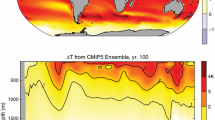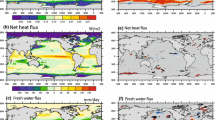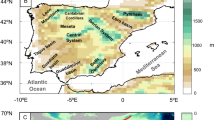Abstract
A very simple, diffusive energy balance atmosphere is coupled to the GFDL ocean circulation model. This provides a useful tool for analyzing climate drift in the ocean model after coupling, and may be used to assess various schemes for minimizing such drift. In the experiment reported here, the atmosphere is constructed in such a way that it provides the ocean model at the moment of coupling with the same fluxes as during spinup. The experiment is therefore equivalent to coupling a perfectly flux-corrected atmosphere model, and is used to investigate the response of the ocean model under these conditions. In spite of the steady, passive, flux-corrected atmosphere, the ocean model drifts to a new equilibrium state after coupling. The transition takes about 2000 years; the new state is characterized by different sites of deep convection and resulting changes in high-latitude SST and global deep temperatures. The mechanism for the transition is an instability of the oceanic convection patterns under the new feedback, felt after coupling. A similar state transition of the ocean model may be triggered by the coupling shock in fully coupled GCMs. If this is so, the transition would contaminate the results of climate scenario experiments, and it would explain part of the residual drift observed in coupled models in spite of the use of flux corrections.
Similar content being viewed by others
References
Bryan K (1984) Accelerating the convergence to equilibrium of ocean-climate models. J Phys Oceanogr 14:666–673
Cubasch U, Hasselmann K, Höck H, Maier-Reimer E, Mikolajewicz U, Santer BD, Sausen R (1992) Time-dependent greenhouse warming computations with a coupled ocean-atmosphere model. Clim Dyn 8:55–69
Cubasch U, Hegerl GC, Hellbach A, Höck H, Mikolajewicz U, Santer BD, Voss R (1995) A climate change simulation starting from 1935. Clim Dyn 11:71–84
Danabasoglu G, McWilliams JC, Gent PR (1994) The role of mesoscale tracer transports in the global ocean circulation. Science 264:1123–1126
England MH (1993) Representing the global-scale water masses in ocean general circulation models. J Phys Oceanogr 23:1523–1552
Haney RL (1971) Surface thermal boundary condition for ocean circulation models. J Phys Oceanogr 1:241–248
Hellerman S, Rosenstein M (1983) Normal monthly wind stress over the world ocean with error estimates. J Phys Oceanogr 13:1093–1104
Houghton JT, Jenkins GJ, Ephraums JJ (eds) (1990) Climate Change. The IPCC Scientific Assessment. Cambridge University Press, Cambridge
Kleeman R, Power SB (1995) A simple atmospheric model of surface heat flux for use in ocean modeling studies. J Phys Oceanogr 25:92–105
Lenderink G, Haarsma RJ (1994) Variability and multiple equilibria of the thermohaline circulation, associated with deep water formation. J Phys Oceanogr 24:1480–1493
Levitus S (1982) Noaa Professional Paper, 13: Climatological atlas of the world ocean, vol 13. US Dept. of Commerce, NOAA, Washington DC
Maier-Reimer E, Mikolajewicz U, Hasselmann K (1993) Mean circulation of the Hamburg LSG OGCM and its sensitivity to the thermohaline surface forcing. J Phys Oceanogr 23:731–757
Manabe S, Stouffer RJ (1988) Two stable equilibria of a coupled ocean-atmosphere model. J Clim 1:841–866
Manabe S, Stouffer RJ (1994) Multiple-century response of a coupled ocean-atmosphere model to an increase of atmospheric carbon dioxide. J Clim 7:5–23
Marotzke J (1994) Ocean models in climate problems. In: Malanotte-Rizzoli P, Robinson AR (eds) Ocean processes in climate dynamics: global and Mediterranean examples. Kluwer, Dordrecht
Pacanowski R, Dixon K, Rosati A (1991, 1993) The GFDL modular ocean model users guide, GFDL Ocean Group Tech Rep vol 2. GFDL, Princeton
Power SB (1995) Climate drift in a global ocean general circulation model. J Phys Oceanogr 25:1025–1036
Rahmstorf S (1993) A fast and complete convection scheme for ocean models. Ocean Modelling 101:9–11
Rahmstorf S (1994) Rapid climate transitions in a coupled oceanatmosphere model. Nature 372:82–85
Rahmstorf S (1995a) Comment on “Instability of the thermohaline circulation with respect to mixed boundary conditions”. J Phys Oceanogr (in press)
Rahmstorf S (1995b) Multiple convection patterns and thermohaline flow in an idealised OGCM. J Clim (in press)
Rahmstorf S, Willebrand J (1995) The role of temperature feedback in stabilizing the thermohaline circulation. J Phys Oceanogr 25:787–805
Santer BD, Brtiggemann W, Cubasch U, Hasselmann K, Höck H, Maier-Reimer E, Mikolajewicz U (1994) Signal-to-noise analysis of time-dependent greenhouse warming experiments. Clim Dyn 9:267–285
Sausen R, Barthel K, Hasselmann K (1988) Coupled ocean-atmosphere models with flux correction. Clim Dyn 2:145–163
Stone PH, Miller DA (1980) Empirical relation between seasonal changes in meridional temperature gradients and meridional fluxes of heat. J Atmospheric Sci 37:1708–1721
Weaver AJ, Hughes TMC (1992) Stability and variability of the thermohaline circulation and its link to climate. In: Research Trends Series: Trends in physical oceanography. Council of Scientific Research Integration, Trivandrum, India
Weaver AJ, Hughes TMC (1994) Rapid interglacial climate fluctuations driven by North Atlantic ocean circulation. Nature 367:447–450
Author information
Authors and Affiliations
Rights and permissions
About this article
Cite this article
Rahmstorf, S. Climate drift in an ocean model coupled to a simple, perfectly matched atmosphere. Climate Dynamics 11, 447–458 (1995). https://doi.org/10.1007/BF00207194
Received:
Accepted:
Issue Date:
DOI: https://doi.org/10.1007/BF00207194




